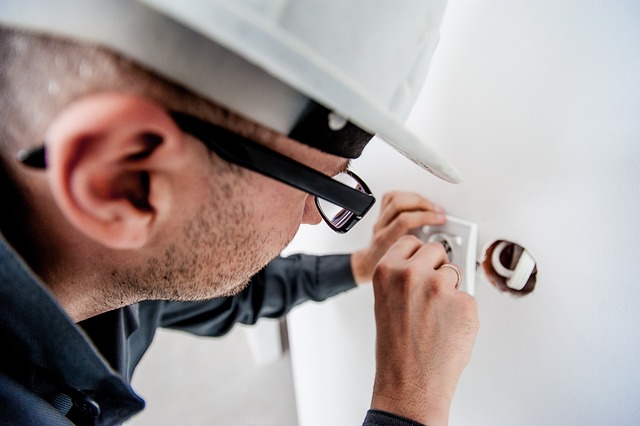An electrician is vital for creating optimal lighting in homes and businesses, catering to diverse spaces' unique needs. They balance functionality with aesthetic appeal by tailoring lighting plans based on space use, ambiance, and lighting types (e.g., LED, incandescent). Their skills include strategic fixture placement, automated control via dimmers, timers, and sensors, enhancing convenience and energy conservation. By blending general and task lighting, electricians craft inviting spaces that cater to practical and personal preferences. They also incorporate natural light through strategic window and skylight placement, boosting efficiency and occupant well-being. Safety is paramount, with electricians ensuring standard compliance, proper grounding, and guidance on energy-efficient LED bulbs.
“Illuminate your spaces with precision: A well-designed lighting plan can transform any home or business, enhancing ambiance and functionality. This comprehensive guide navigates the essentials of professional lighting design. From understanding diverse space requirements to safety considerations, we explore essential tools and strategies. Learn how to balance general and task lighting, maximize natural daylighting, and choose suitable fixtures for a safe, efficient setup. Elevate your environment with expert insights from an electrician.”
- Understanding Lighting Needs: Different Spaces, Different Requirements
- Essential Tools for a Successful Lighting Plan
- Creating a Balanced Lighting Design: General and Task Lighting
- Incorporating Natural Light: Maximizing Daylighting Potential
- Safety Considerations: Choosing the Right Fixtures and Electrical Systems
Understanding Lighting Needs: Different Spaces, Different Requirements

Every space, whether it’s a cozy living room or a bustling office, has unique lighting needs. Understanding these requirements is key to creating an effective lighting plan. A professional electrician knows that a home and business environment demand distinct approaches due to variations in use, ambiance, and functionality.
For instance, a kitchen requires task lighting for food preparation while also benefiting from ambient light for dining. In contrast, a relaxing bedroom may prioritize softer, dimmable lighting for comfort, whereas a vibrant retail store needs bright, focused illumination to showcase products effectively. An electrician tailors lighting plans to these differences, ensuring each space receives the right balance of brightness, color temperature, and control options for optimal functionality and aesthetic appeal.
Essential Tools for a Successful Lighting Plan

When it comes to designing lighting plans for optimal illumination, both in homes and businesses, a professional electrician is an essential tool. Their expertise ensures that every light fixture is strategically placed to meet specific needs, enhancing aesthetics while optimizing energy efficiency.
An electrician brings a wealth of knowledge regarding different types of lighting, from LED to incandescent, and their unique applications. They also possess the skills to install dimmers, timers, and motion sensors, allowing for adjustable and automated lighting control. These tools not only enhance convenience but also play a significant role in energy conservation, making your space more environmentally friendly.
Creating a Balanced Lighting Design: General and Task Lighting

Creating a balanced lighting design is an art that involves striking a harmonious mix between general and task lighting. General lighting, often provided by ceiling fixtures or overhead lights, sets the overall ambiance and illuminates larger spaces. It’s like the painter’s canvas; it provides the basic illumination for any room, creating a warm and inviting atmosphere. On the other hand, task lighting focuses on specific areas where detailed work is done, such as reading a book, cooking in the kitchen, or working at a desk. This targeted approach ensures these tasks are completed efficiently without strain, making it akin to the fine details added by an artist with a precise brush.
An electrician plays a pivotal role in achieving this balance. They can suggest lighting arrangements that distribute general light evenly while incorporating task lighting strategically. By understanding the spatial requirements and intended uses of each area, electricians can design lighting plans that enhance functionality and aesthetics. This dual consideration ensures spaces are not only well-lit but also aesthetically pleasing, catering to both practical needs and personal preferences.
Incorporating Natural Light: Maximizing Daylighting Potential

Incorporating natural light, or daylighting, is a key strategy for any electrician designing lighting plans. It’s an environmentally friendly and cost-effective way to illuminate spaces, reducing reliance on artificial lighting. By strategically placing windows, skylights, and reflectors, you can maximize the available sunlight during the day, making interior spaces brighter and more inviting.
Electricians play a vital role in optimizing this natural resource by ensuring proper insulation, window treatments, and reflective surfaces within the building design. This approach not only enhances energy efficiency but also positively impacts occupants’ moods, productivity, and overall well-being—all while reducing carbon footprints.
Safety Considerations: Choosing the Right Fixtures and Electrical Systems

When designing lighting plans, safety should always be a top priority. An electrician plays a crucial role in ensuring that the chosen fixtures and electrical systems meet all necessary safety standards. This includes selecting weather-resistant fixtures for outdoor spaces and properly grounding electrical connections to prevent accidents.
Moreover, it’s essential to consider the type of lighting bulbs used, as some can generate significant heat. Selecting energy-efficient LED bulbs can help mitigate this risk while also reducing electricity costs. A qualified electrician can provide guidance on suitable fixtures, wiring, and installation practices to create a safe and well-lit environment for both homes and businesses.
When designing lighting plans for homes or businesses, understanding space-specific requirements and incorporating natural light are key. Using the right tools and considering safety aspects, such as choosing suitable fixtures and electrical systems, ensures optimal illumination. An electrician plays a vital role in implementing these designs, ensuring both functionality and safety. By balancing general and task lighting, you can create a harmonious and efficient lighting environment that enhances any space.
